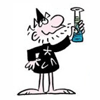Ask The Vet: Wash Hands After Removing Tick From Pet
Q: What's the best way to remove a tick embedded in my dog Floyd's skin? I tried covering the tick with alcohol, nail polish and petroleum jelly, but nothing loosened its grip. I've heard that touching a lit match to the tick works, but I'm afraid I'll burn Floyd. What do you recommend?
A: None of these techniques is effective. They just irritate the tick, making it regurgitate its gut contents -- including any harmful bacteria -- into the dog. And a lit match can produce an even worse outcome.
So, let me offer a few safer and more effective alternatives.
My favorite way to remove a tick is to use a tick puller. Popular brands are Ticked Off, a small spoon with a V-shaped notch in front, and Tick Twister, which looks like a tiny fork. Simply slide the tick puller under the tick, and lift it from the skin.
Or, you can use tweezers to grasp the tick as close to the skin as possible and pull it out. A final option is to don thin latex gloves and pluck the tick off.
Tape the tick to a card, write the date on the card, and seal it inside a plastic bag. If Floyd gets sick, take him and the tick to your veterinarian, who can identify the tick and diagnose and treat Floyd's illness.
Other disposal options include flushing the tick down the toilet or putting it in a small vial of alcohol.
Finish by washing the bite site and your hands, since bacteria in ticks can cause infections in humans as well as dogs.
You can prevent ticks from causing problems by using a product that prevents tick attachment or kills ticks soon after they bite Floyd. Chewable tablets, drops applied to the skin and tick collars are available. Ask your veterinarian for a recommendation.
Q: I have an indoor-outdoor cat named Babette, so I was concerned when I noticed a yellow-green puddle beneath a car near my home. I assumed it was antifreeze and hosed it down. Was that adequate, or should I take Babette to her veterinarian and have her checked?
A: You're right that the majority of yellow-green puddles are antifreeze. Most antifreeze products contain ethylene glycol, or EG, a highly toxic chemical that damages the kidneys.
Cats are more than twice as sensitive to EG as dogs. Babette could ingest a lethal dose by merely walking through a puddle and then licking her paws.
EG also poisons wildlife and any children who sample the sweet-tasting liquid. Bitter flavoring is added to some EG brands to decrease their appeal, but poisoning is still much too common.
Clinical signs include vomiting, diarrhea, increased drinking and urination, disorientation, loss of coordination, rapid heartbeat, trouble breathing, seizures and coma. Death is usually due to kidney failure.
EG is rapidly absorbed, so if you suspect Babette might have been exposed to it, rush her to a veterinarian immediately.
It's not just antifreeze that contains EG but also brake fluid, heat exchangers, home solar units, condensers, products used to winterize toilets and even some imported snow globes.
Soak up spills using paper towels, rags or cat litter. Dispose of the contaminated materials in trash bags secured in a garbage can. Don't hose down the area, as that only spreads the poison, which remains toxic even when diluted.
When your mechanic changes your vehicle's coolant, request propylene glycol antifreeze, which is much safer for animals and children. Popular brands are Sierra and Prestone LowTox.
========
Lee Pickett, VMD, practices companion animal medicine in North Carolina. Contact her at https://askthevet.pet.
Copyright 2024 Creators Syndicate Inc.








Comments